|
|
 |
|
|
|
| HEALTH |
|
| Eye Health Initiatives under NYSASDRI: A Commitment to Restoring Vision and Lives |
| Eye health is more than preserving visual acuity it’s about restoring independence, dignity, education, livelihoods, and hope. At NYSASDRI, we believe in inclusive, accessible healthcare that addresses the holistic well being of individuals, and eye health is a cornerstone of this vision. NYSASDRI’s work in this domain is channelled primarily through its flagship institution, Kalinga Eye Hospital, located in Dhenkanal, Odisha. |
|
| Kalinga Eye Hospital: The Epicentre of Community Eye Care |
 Established originally as NYSASDRI Eye Hospital in Santhasara village in 1988, Kalinga Eye Hospital has evolved into central Odisha’s most advanced and community rooted eye care institute. NABH accredited and empanelled under schemes such as CGHS (Central Government Health Scheme), Ayushman Bharat, and Gopabandhu Jan Arogya Yojana, the hospital stands as a beacon of trust and excellence. Established originally as NYSASDRI Eye Hospital in Santhasara village in 1988, Kalinga Eye Hospital has evolved into central Odisha’s most advanced and community rooted eye care institute. NABH accredited and empanelled under schemes such as CGHS (Central Government Health Scheme), Ayushman Bharat, and Gopabandhu Jan Arogya Yojana, the hospital stands as a beacon of trust and excellence.
Established originally as NYSASDRI Eye Hospital in Santhasara village in 1988, Kalinga Eye Hospital has evolved into central Odisha’s most advanced and community rooted eye care institute. NABH accredited and empanelled under schemes such as CGHS (Central Government Health Scheme), Ayushman Bharat, and Gopabandhu Jan Arogya Yojana, the hospital stands as a beacon of trust and excellence.
|
|
| A Dual Delivery Model: Hospital-Based and Community Outreach Services |
Patients coming directly to the hospital receive comprehensive eye care services, including consultation, diagnostics, surgeries, spectacle dispensation, and medical management. However, recognising the geographical and socio economic barriers many face, the hospital’s outreach services are designed to reach the unreached.
Every day, technical teams from the hospital venture into communities through nearly 300 eye camps annually, supported by kind hearted individuals, corporates, and NGOs. These camps extend care to underserved populations screening thousands, referring surgical cases, and raising awareness.
|
|
| Vision Centres: Anchoring Primary Eye Care in Rural Odisha |
Given the vastness of the region and the challenge of covering thousands of villages, Kalinga Eye Hospital introduced Vision Centres fixed primary eye care facilities situated in remote locations. Currently, seven Vision Centres operate in:
- Khajurikata, Gondia, Bhuban (Dhenkanal)
- Athagarh (Cuttack)
- Athamallik, Koshala, and Pallahara (Angul)
Two of these, Bhuban & Gondia operate from Government Health Facilities, while the rest are set up in rented premises. These centres offer services like refraction, cataract identification, minor treatments, and referrals. In 2024-25 alone, 14,908 people were screened through these centres, leading to over 1,600 cataract detections and nearly 10,000 people receiving corrective spectacles or medical treatment.
|
|
| Specialized Camps: Tailored Outreach for Targeted Populations |

In addition to general eye camps, Kalinga Eye Hospital conducts:
- Diabetic Retinopathy Screening Camps
- Eye Camps for Industrial Workers and Weavers
- Camps inside Forest Areas
- Driver Screening Camps
- School Eye Health Camps
One such innovative initiative, RAAHI: Safe Eyes, Safer Roads, is Odisha’s largest eye care intervention for truck drivers, in partnership with JSPL and Sightsavers India. Over 8,600 drivers were screened, with 3,500+ spectacles provided and thousands receiving eye medications helping improve road safety and their quality of life.
|
|
| Child Eye Health: A Vision for the Next Generation |
| Through its School Eye Health Program, the hospital conducts mass screenings of school-going children and reaches non school going children through ASHA and Anganwadi workers. In 2023-24, in Keonjhar district alone, 70,404 children from 717 schools were screened. Of these, 2,100 children received spectacles, 15 required surgeries, and 09 were prescribed low vision devices.
Children who are verbal, non verbal, school dropouts, or infants with their mothers are all included in a comprehensive approach that ensures no child between 0-16 years are left behind.
|
|
| Empowerment through Knowledge: Building a Skilled Eye Health Workforce |
Kalinga Eye Hospital doesn’t only serve patients; it builds capacity across the healthcare ecosystem:
- Staff Training: In house and through deputations to national eye care institutes.
- Visiting Experts: Invited for hospital based training programs.
- Continuing Medical Education (CME) for local doctors and clinical staff.
- Community Empowerment: Training schoolteachers, ASHA workers, Anganwadi workers, Forest Animators and volunteers with scientifically designed screening kits.
The idea is simple: decentralize early detection and facilitate timely referrals whether to Kalinga or any other trusted facility.
Additionally, the hospital trains youth in eye health professions, offering certificate courses in Optometry, Ophthalmic Assistance, and Vision Technician Programs, often in collaboration with government schemes and academic institutions.
|
|
| International Engagement: A Global Touch to Local Impact |
| Volunteers and healthcare professionals from countries across the world frequently visit Kalinga Eye Hospital. While international doctors don’t perform surgeries without MCI clearance, they contribute to knowledge sharing, program development, and training. |
|
| The Vision Care Project: A Landmark Initiative |
 On 1st July 2024, Kalinga Eye Hospital launched the Vision Care Project, aiming to screen 300,000 individuals and provide 65,000 spectacles over two years. Inaugurated by Odisha’s Hon’ble Minister Shri Krushna Chandra Patra, the project is a model of public private cooperation. This initiative brings large-scale, preventive, and curative eye care services to underserved regions one of the biggest of its kind in Odisha. On 1st July 2024, Kalinga Eye Hospital launched the Vision Care Project, aiming to screen 300,000 individuals and provide 65,000 spectacles over two years. Inaugurated by Odisha’s Hon’ble Minister Shri Krushna Chandra Patra, the project is a model of public private cooperation. This initiative brings large-scale, preventive, and curative eye care services to underserved regions one of the biggest of its kind in Odisha. |
|
| A Legacy of Service and a Future of Vision |
| From humble beginnings in 1988 to a 30,000 sq. ft. NABH accredited facility serving thousands, Kalinga Eye Hospital is more than a hospital it’s a movement for vision equity. NYSASDRI, through this centre of excellence, ensures that eye health is not a privilege but a right.
We remain deeply grateful to the Government of India, Government of Odisha, and our compassionate partners international organizations like Unite for Sight, SEVA, and Distressed Children and Infants International (DCI), as well as dedicated Indian NGOs and corporates such as Sightsavers India, Shrimad Rajchandra Love & Care, State Bank of India, LIC, GMR Foundation, Tata Trust, and others whose continuous support makes our community eye care initiatives possible and impactful. Their belief in our mission continues to bring light and dignity into countless lives.
|
|
| Health Awareness through the Meickirch Model (An Innovative Health Approach) |
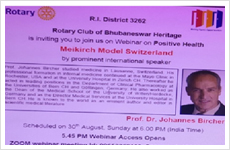 According to the Meikirch model, health is a "complex adaptive system". The Meikirch model of health consists of five components: demands of life, biologically-given potential, personally-acquired potential, social determinants of health, and environmental determinants of health. The first component (demands of life)is based on the idea that each human has to fulfil the biological, psychosocial, and environmental demands that life brings them. The biological demands include access to clean water; adequate nutrition; appropriate hygiene; and protection from cold, wetness, and natural catastrophes. The second component (biologically-given potential) is a gift of nature, along with our responsibility to take good care of that gift through balanced nutrition; hygiene; vaccinations; life-long learning; appropriate physical activity; a healthy lifestyle; and avoidance of smoking, alcohol, and drugs. The third component (personally-acquired potential) is promoted when a person pursues a purpose in life, cultivates positive feelings, practices meditation, seeks spirituality, etc. The fourth component (social determinants) includes good human relationships and the ability to avoid anxiety, greed, and abuse of power. Finally, the fifth component (environmental determinants) articulates the fact that environmental protection is essential for health. These five components interact with each other; when they cooperate in a purposeful way, the result is good health. During the year, NYSASDRI demonstrated the Meikrich Model approach in different villages through village meetings. The concept was also shared among the participants of different capacity-building trainings through NYSASDRI.NYSASDRI team members shared this model with participants of diverse backgrounds through various conferences and workshops .The team emphasized the similarities between the Meikrich Model and Swachha Bharat Abhijana, clean India Movement of Govt of India pleaded the community for personal hygiene, hand washing, cleanliness of surroundings, use of shoes, mosquito nets and ban of polythene/plastic materials. Information Education and Communication (IEC) materials were also distributed for better sensitization. It was observed that in the aftermath of the Fani cyclone, people faced disruptions in various services and commodities, including electricity, telephone, mobile phone tower, drinking water supply, road communication, and availability of essential food stuffs for several days. Being fully dependent upon man-made facilities, communities were unable to adjust in the post-disaster period. Thus, coastal area communities were sensitized to enhance their acquired potentiality to manage such type of situation. According to the Meikirch model, health is a "complex adaptive system". The Meikirch model of health consists of five components: demands of life, biologically-given potential, personally-acquired potential, social determinants of health, and environmental determinants of health. The first component (demands of life)is based on the idea that each human has to fulfil the biological, psychosocial, and environmental demands that life brings them. The biological demands include access to clean water; adequate nutrition; appropriate hygiene; and protection from cold, wetness, and natural catastrophes. The second component (biologically-given potential) is a gift of nature, along with our responsibility to take good care of that gift through balanced nutrition; hygiene; vaccinations; life-long learning; appropriate physical activity; a healthy lifestyle; and avoidance of smoking, alcohol, and drugs. The third component (personally-acquired potential) is promoted when a person pursues a purpose in life, cultivates positive feelings, practices meditation, seeks spirituality, etc. The fourth component (social determinants) includes good human relationships and the ability to avoid anxiety, greed, and abuse of power. Finally, the fifth component (environmental determinants) articulates the fact that environmental protection is essential for health. These five components interact with each other; when they cooperate in a purposeful way, the result is good health. During the year, NYSASDRI demonstrated the Meikrich Model approach in different villages through village meetings. The concept was also shared among the participants of different capacity-building trainings through NYSASDRI.NYSASDRI team members shared this model with participants of diverse backgrounds through various conferences and workshops .The team emphasized the similarities between the Meikrich Model and Swachha Bharat Abhijana, clean India Movement of Govt of India pleaded the community for personal hygiene, hand washing, cleanliness of surroundings, use of shoes, mosquito nets and ban of polythene/plastic materials. Information Education and Communication (IEC) materials were also distributed for better sensitization. It was observed that in the aftermath of the Fani cyclone, people faced disruptions in various services and commodities, including electricity, telephone, mobile phone tower, drinking water supply, road communication, and availability of essential food stuffs for several days. Being fully dependent upon man-made facilities, communities were unable to adjust in the post-disaster period. Thus, coastal area communities were sensitized to enhance their acquired potentiality to manage such type of situation. |
|
| Public Private Partnership and Management of Primary Health Centres (PHC) |
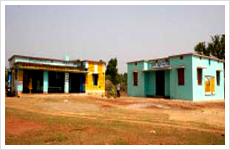 For the first time, Odisha's Primary Health Centres were transferred from the Government to NYSASDRI, following extensive negotiations. After continuous advocacy at the state level, in August/September 2005, the Minister of Health announced the government's trial of transferring primary health centres to NYSASDRI. The MoU was signed by the District Collector, Jajpur, Chief District Medical Officer; In-charge Community health Centre, Sukinda & Director NYSASDRI for PHC (N) Atta was done on October 28, 2005 in Jajpur. However the process of signing the MoU in Dhenkanal was more complex. On November 16, 2005, the District Collector and Chief District Medical Officer wanted certain alterations to the text of the agreement; these alterations had to be validated by the state NGO coordinator. Following a series of reminders to the CDMO, the MoU signing took place on January 1, 2006. A series of activities like renovation of infrastructure, appointed trained adequate personnel, regularise the patient treatment with institutional delivery, provided need based capacity building training, formation and strengthen of Rogi Kalyan Samiti etc were undertaken after receiving the signed MoU from both the districts of Jajpur and Dhenkanal. For the first time, Odisha's Primary Health Centres were transferred from the Government to NYSASDRI, following extensive negotiations. After continuous advocacy at the state level, in August/September 2005, the Minister of Health announced the government's trial of transferring primary health centres to NYSASDRI. The MoU was signed by the District Collector, Jajpur, Chief District Medical Officer; In-charge Community health Centre, Sukinda & Director NYSASDRI for PHC (N) Atta was done on October 28, 2005 in Jajpur. However the process of signing the MoU in Dhenkanal was more complex. On November 16, 2005, the District Collector and Chief District Medical Officer wanted certain alterations to the text of the agreement; these alterations had to be validated by the state NGO coordinator. Following a series of reminders to the CDMO, the MoU signing took place on January 1, 2006. A series of activities like renovation of infrastructure, appointed trained adequate personnel, regularise the patient treatment with institutional delivery, provided need based capacity building training, formation and strengthen of Rogi Kalyan Samiti etc were undertaken after receiving the signed MoU from both the districts of Jajpur and Dhenkanal. |
|
| Community Empowerment & Advocacy for Sustainable Health Care for People in Extreme Need in Odisha |
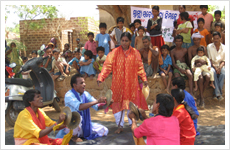 The project titled "Community Empowerment & Advocacy for Sustainable Health Care for People in Extreme Need in Odisha" (CEASH) was implemented by NYSASDRI in the Gondia Block of Dhenkanal and in the Sukinda Block of Jajpur, District of Odisha. The project is operative in 19 Gram Panchayats and covers a population of about 100,000 people. Started in September 2004.. The project aims to empower the poorest communities and increase the effectiveness of the Panchayat Raj Institutions (PRIs) and the civil society, thereby reducing poverty. Another goal of the project is to improve the health practices of underserved communities. The project focuses on six major components: community empowerment, strengthening of PRIs, increasing health service accessibility through primary health centres (PHC), education, advocacy for health sector reform, and capacity building of the civil society organizations. The project titled "Community Empowerment & Advocacy for Sustainable Health Care for People in Extreme Need in Odisha" (CEASH) was implemented by NYSASDRI in the Gondia Block of Dhenkanal and in the Sukinda Block of Jajpur, District of Odisha. The project is operative in 19 Gram Panchayats and covers a population of about 100,000 people. Started in September 2004.. The project aims to empower the poorest communities and increase the effectiveness of the Panchayat Raj Institutions (PRIs) and the civil society, thereby reducing poverty. Another goal of the project is to improve the health practices of underserved communities. The project focuses on six major components: community empowerment, strengthening of PRIs, increasing health service accessibility through primary health centres (PHC), education, advocacy for health sector reform, and capacity building of the civil society organizations. |
|
| 1. Community Empowerment |
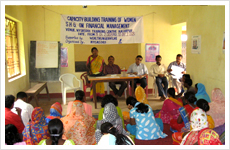 Under the auspices of the CEASH project, community groups have been formed and strengthened in the target villages. At present, 150 all-female self-help groups (containing a total of 1,781 people) are working to improve the health and sanitation of their communities. They are also working to create income-generating activities. The self-help group (SHG) members have raised Rs.29,80,871/-. The SHG members have also received a loan for Rs. 3,000,000/-, so that they will have the capital to start their own businesses. Under the auspices of the CEASH project, community groups have been formed and strengthened in the target villages. At present, 150 all-female self-help groups (containing a total of 1,781 people) are working to improve the health and sanitation of their communities. They are also working to create income-generating activities. The self-help group (SHG) members have raised Rs.29,80,871/-. The SHG members have also received a loan for Rs. 3,000,000/-, so that they will have the capital to start their own businesses.
The improvements in both financial status and living status are startling results within the all-women groups, and it has been a regular practice among group members to recycle the amount at crisis periods. Today, they are maintaining their own records, cooperating with government officials, and managing their bank linkage without any external support. Clearly, the income-generating activities that the SHGs have taken part in are improving the members' quality of life.
CEASH has also worked to raise awareness among community members regarding health practices, government involvement in the health sector, and the implementation of the National Rural Employment Guarantee Act NREGA. The group members are making an individual effort to send their children to school more frequently, and are also teaching illiterate women to read. Further, they participate in Palli Sabha and Gram Sabha, learning about sexual and reproductive health care SRH and HIV/AIDS. The SHG members are learning about health practices, issues, and services such as hand-washing, water-borne disease, breastfeeding, and the role of Gram Panchayat. The group members are not only working to educate themselves, but also to educate their communities.
65 all-male self-help groups are participating in developmental work, such as monitoring government projects and facilities in the GP (Gram Panchayat)in addition to monitoring health and education institutions like Anganwadi Centres AWCs and schools. The groups have also been focusing on the protection of the village forests, and are working against deforestation.
Kishori Clubs are groups of adolescent girls who work in the same way that the self-help groups do. 81 Kishori clubs have been mobilizing the community by advocating for marriage at the appropriate age, maintenance of menstrual hygiene, for prevention of STI/RTI. The Kishori Clubs have been able to prevent four instances in which early marriage was imminent, namely in the Baidakateni, Chhotatentuli, and Gomharia villages. The adolescent girls have also taken an active role in HIV/AIDS awareness campaigns through rallies and meetings with villagers. As a result, they are able to dispel myths and social taboos related to HIV/AIDS. The Kishori Clubs are working to gain the support of the panchayat and the block administration to provide support to the affected families. |
|
| 2. Emergency Obstetric Contingency Committee (EOCC) Merged in GaonKalyan Samiti (GKS) |
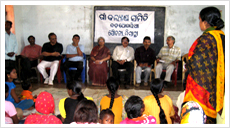 Out of the 66 (26 in Sukinda Block and 40 in Gondia Block) Emergency Obstetric Contingency Committees (EOCC) which had been formed earlier within this project, 48 are now subsumed into Gaon Kalyana Samitis (GKS). The other Committees have been formed per the norms of the National Rural Health Mission (NRHM). Out of these, 7 Gaon Kalyana Samitis have opened accounts at State Bank of India (SBI), Sadangi. Out of the 66 (26 in Sukinda Block and 40 in Gondia Block) Emergency Obstetric Contingency Committees (EOCC) which had been formed earlier within this project, 48 are now subsumed into Gaon Kalyana Samitis (GKS). The other Committees have been formed per the norms of the National Rural Health Mission (NRHM). Out of these, 7 Gaon Kalyana Samitis have opened accounts at State Bank of India (SBI), Sadangi. |
|
| 3. Strengthening Panchayat Raj Institutions (PRIS) |
| A monthly Gram Panchayat Health Committee (GPHC) meeting has been established by the PRI members. These meetings cover issues such as the regularization of the integrated child Development Scheme (ICDS), delivery of children in hospital facilities (institutional deliveries), malaria prevention, and safe drinking water. The PRI members have not only discussed these health issues themselves, but have also participated proactively in the implementation and monitoring of health service delivery in their areas. |
|
| 4. Service Delivery through Primary Health Centre (PHC) |
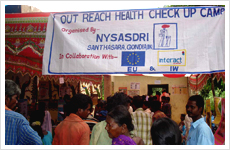 Primary Health Centres, supported through a partnership with the government and other stakeholders, have been running in Atta of Jajpur and Khankira of Dhenkanal District since January 2006 and February 2006, respectively. Outreach camps in remote and inaccessible areas have helped to meet the health care needs of the disadvantaged and poor. Regular outreach services and the initiation of institutional deliveries at the PHC level have contributed to an increase in the confidence level of the beneficiaries, as they now have basic health care within their reach. Further, the 24-hour service provided through the PHCs has increased the patient inflow. Health camps also create a wider patient base by covering villages that PHCs previously could not cover. We have also displayed IEC materials in these villages, which helps to raise awareness about immunization, nutrition, HIV/AIDS, STDs, and RTIs among the villagers. After regular negotiations with government authorities, we have successfully earned the authority to construct a new PHC building at Khankira. This building consists of a doctor's room, a dispensing room, a 5-bed ward, and a labor room with an attached bathroom. Primary Health Centres, supported through a partnership with the government and other stakeholders, have been running in Atta of Jajpur and Khankira of Dhenkanal District since January 2006 and February 2006, respectively. Outreach camps in remote and inaccessible areas have helped to meet the health care needs of the disadvantaged and poor. Regular outreach services and the initiation of institutional deliveries at the PHC level have contributed to an increase in the confidence level of the beneficiaries, as they now have basic health care within their reach. Further, the 24-hour service provided through the PHCs has increased the patient inflow. Health camps also create a wider patient base by covering villages that PHCs previously could not cover. We have also displayed IEC materials in these villages, which helps to raise awareness about immunization, nutrition, HIV/AIDS, STDs, and RTIs among the villagers. After regular negotiations with government authorities, we have successfully earned the authority to construct a new PHC building at Khankira. This building consists of a doctor's room, a dispensing room, a 5-bed ward, and a labor room with an attached bathroom. |
|
| 5. Learning and Knowledge Dissemination |
A state wide workshop ("Workshop on PPP in PHC management - A Way Forward") was organized at the May Fair Lagoon Hotel on February 13-14, 2009. Academics, researchers, politicians, representatives of the NRHM/Odisha , RRC, media, PRI, and NGOs who were involved in PHC management participated. In this 2-day deliberation, different stakeholders shared their experiences and made suggestions to finalize the draft of the PPP policy developed by the NRHM.
A workshop on the prospects and constraints of public private partnerships in the field of primary health care was held on October 16, 2008 at the Jajpur town hall of the Jajpur District. 55 participants, including the media, PRI representatives, CSO members, government officials, NGO representatives, and other health-related professionals participated. This workshop reflected on the effectiveness of PPP interventions and challenges by PHCs towards the health care of the poor, marginalized, and disadvantaged people of rural Odisha. |
|
| 6. Advocacy for Health Sector Reform |
| After continuous lobbying with various state-, district-, and local-level officials, NYSASDRI has signed a revised MoU with the state while still waiting for approval from the district office. A new Auxiliary nurse midwife (ANM) has been appointed at the Khankira PHC (N) and an Ayurveda, Yoga & Naturopathy, Unani, Siddha and Homeopathy (AYUSH) doctor at the PHC (N), Atta. A new building, an open well, and a labor room have been constructed at the Khankira PHC (N) under the support of the RKS funds. |
|
| 6. Staff Capacity-Building |
| The capacity-building of the staff has been accelerated through various training programs. These includes "Gender for OD, SRH & R", "MCH", "Strategy Planning", "Orientation of Log Frame and Filling", "Documentation and Record Keeping", "Rights and Advocacy", "BCC", "CBO and Male Group Management", "NRHM and NREGA", and "Public Health Sector Reform Process". As a result, the staff members have acquired expertise on ten key areas of the project, and are able to educate other community members. |
To explore more about our ongoing work, success stories, and partnerships, visit: www.kalingaeyehospital.org
|
| CEASH Low Resolution PDF
|
|
| |
| |
|
|
|
|